In 1977, Ray Gallagher created a national debate on afforestation in Ireland when he claimed that one-third of the farmers in south Sligo could introduce forestry on their farms as a profitable enterprise.
The resulting debate focused on private forestry as a viable land, use especially in western counties.
Afforestation was – and remains – a heated topic, but Gallagher, an agricultural adviser, stuck to his guns and brought farmers, and the then Forest and Wildlife Service, round to his way of thinking.
His vision was for a co-operative approach to forest establishment.
The catchment area of the co-ops involved, covers most of the gley soils in the drumlin region, identified on the Teagasc soil maps as ideal for forestry
He was appointed manager of the newly formed Western Forestry Co-operative Society in 1985, with the support of the Irish Co-operative Organisation Society (ICOS) and seven co-ops.
“The catchment area of the co-ops involved, covers most of the gley soils in the drumlin region, identified on the Teagasc soil maps as ideal for forestry,” says Marina Conway, CEO of Western Forestry Co-op.
“The main objectives of the new co-operative were to improve farm incomes, create employment in remote rural areas and work with local communities in maximising the wood and non-wood benefits of a planned forestry programme.”
Western Forestry Co-op
In the beginning, Western Forestry concentrated on breaking down the strong prejudices against forestry, not only among farmers, but also farm organisations and advisory services.
The co-op organised farmer meetings, including field trips to State forests and seminars, before the first forest group was established in southeast Sligo in 1987.
Despite some opposition, 18 further farmers planted over 200ha of marginal land within a radius of five miles over the following three years
The group comprised seven farmers in the Ballindoon area who between them planted 27ha in what was an ingenious socio-economic co-operative forestry experiment.
It involved swapping land suitable for forestry for land that some farmers wished to retain for agriculture. Despite some opposition, 18 further farmers planted over 200ha of marginal land within a radius of five miles over the following three years.
Recently, I was accompanied on a tour of southeast Sligo by Marina and Victor Barber, harvest manager, Western Forestry, to see how these forests are faring.
Golden Vale of Forestry
Standing in Martin Foley’s harvested site in Cornamucklagh, it is difficult to see why there was – and still is – resistance to forestry. He was one of the original Ballindoon group and regards the initiative as the right one for the region, which he refers to as the “Golden Vale of Forestry” because of its high timber yield.
I prefer to see local people owning the land and contributing to the community rather than institutional investors
He saw the worth of the co-op’s approach from the beginning and planted Cornamucklagh in 1990, three years after his initial plantation. He now owns 16ha of forests and has transferred 12ha to his son.
“I prefer to see local people owning the land and contributing to the community rather than institutional investors,” he says.
“For example, in this area, forest owners contributed financially to the building and upgrading of public roads in collaboration with the county council. This was in contrast to the private investors, who declined to contribute even though they enjoy the benefits of this work.”
The Cornamucklagh site is busy when we arrive, as harvesting and haulage are being carried out on the clearfell site, which will be followed by ground preparation and planting later in the year.
Victor outlines the destination of the logs, which will be processed in sawmills, stake mills and wood energy outlets in counties Sligo, Fermanagh, Cavan, Leitrim and Donegal.
Employment
Martin dismisses the argument that forestry leads to depopulation, as he counts seven people working on the site, some of whom are locals, who have set up their own harvesting operations.
My daughter and her husband plan to return from Liverpool to build a house here in the forest. The forest ensures that she still has roots here
“Forestry creates employment, if farmers carry out the planting,” he says.
“My daughter and her husband plan to return from Liverpool to build a house here in the forest. The forest ensures that she still has roots here and there are other examples of the children of many of those who planted returning to build houses and live in this community.”
He accepts that forestry needs to be planned carefully, but says farmers should be allowed decide their destiny without constant objections “often by people from outside the community.”
He cites examples of this opposition, which have led to some farmers quietly selling their land rather than face opposition should they wish to plant some of their holdings.
“This often results in whole farm planting by investors,” he maintains, which could be avoided if farmers were allowed to mix agriculture and forestry.
“You can still plant the marginal land and keep the four green fields,” he says.
Our next stop is to the neighbouring farm of Paddy Joe McDonagh in Moytura West, who also established his forest in 1987. After thinning the site, he clearfelled the crop in 2015. Western Forestry reforested the site within months of clearfell and the second vigorous crop will be first thinned in eight years time.
I’d return from work after a long day, I’d put the cattle up here, but they preferred the better-quality land
He admits to knowing very little about forestry in 1987, but was influenced by Ray Gallagher’s enthusiasm and the State’s attractive grant incentives. But ultimately, opting for forestry was as much a lifestyle choice as an economic decision.
“I was working in Sligo at the time and part-time farming, so when I’d return from work after a long day, I’d put the cattle up here, but they preferred the better-quality land,” he says, pointing to the lowland section of his farm.
“When I heard that this rushy higher land was ideal for forestry, I decided to plant 6ha of the 20ha farm,” which he says was a good financial decision as well as reducing his workload.
“The mistake I made was that I didn’t plant more of the poorer land.”
The harvesters and the hauliers left the roads and forest in excellent condition
Like other forest owners, he is leaving the farm and forest to his two daughters. He pays tribute to Western Forestry for its approach to managing his forest, especially during harvesting.
“The harvesters and the hauliers left the roads and forest in excellent condition,” he says. He also co-operated with his neighbouring forest owner – Seamus Lavin – in facilitating timber haulage over his own forest road.
High yield forestry
The farmers who planted in Ballindoon have been joined by other farmers since the establishment of Western Forestry Co-op. They are producing some of the highest-yielding forests in the world, capable of incomes between €20,000 and €30,000/ha from thinning and final harvest.
They have successfully coped against objections not only at the planting stage but ironically, again, when they applied for felling licences.
Both Martin Foley, Paddy Joe McDonagh and their neighbours in the Ballindoon experiment, continue to reap the rewards of forestry, as will their children and future generations.
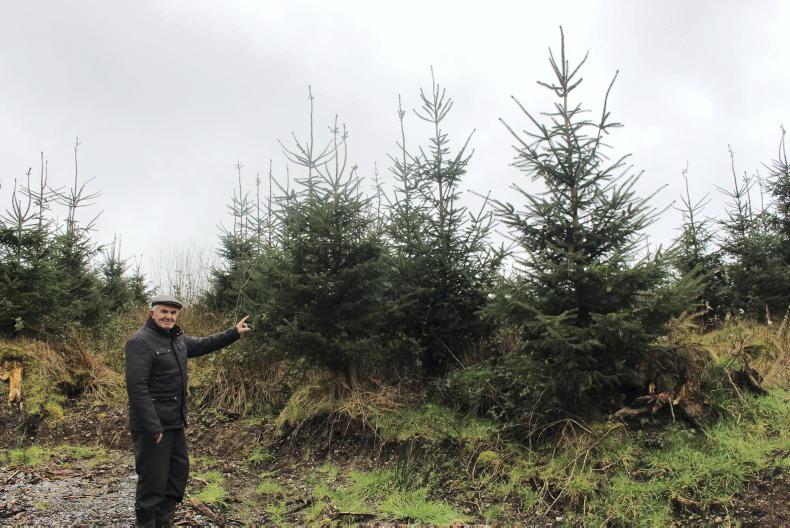
Paddy Joe McDonagh, a member of the original Ballindoon group who established forests in 1987, points to his second rotation Sitka spruce crop in Moytura West now in its seventh growing season.. \Donal Magner
Their advice to farmers is to plant their marginal land and stay on their farms, which is in tune with the ethos of Western Forestry Co-op.
They believe the public should hear the positive news from farmers who have chosen the forestry option rather than negative news from those who would deny them that option.
In 1977, Ray Gallagher created a national debate on afforestation in Ireland when he claimed that one-third of the farmers in south Sligo could introduce forestry on their farms as a profitable enterprise.
The resulting debate focused on private forestry as a viable land, use especially in western counties.
Afforestation was – and remains – a heated topic, but Gallagher, an agricultural adviser, stuck to his guns and brought farmers, and the then Forest and Wildlife Service, round to his way of thinking.
His vision was for a co-operative approach to forest establishment.
The catchment area of the co-ops involved, covers most of the gley soils in the drumlin region, identified on the Teagasc soil maps as ideal for forestry
He was appointed manager of the newly formed Western Forestry Co-operative Society in 1985, with the support of the Irish Co-operative Organisation Society (ICOS) and seven co-ops.
“The catchment area of the co-ops involved, covers most of the gley soils in the drumlin region, identified on the Teagasc soil maps as ideal for forestry,” says Marina Conway, CEO of Western Forestry Co-op.
“The main objectives of the new co-operative were to improve farm incomes, create employment in remote rural areas and work with local communities in maximising the wood and non-wood benefits of a planned forestry programme.”
Western Forestry Co-op
In the beginning, Western Forestry concentrated on breaking down the strong prejudices against forestry, not only among farmers, but also farm organisations and advisory services.
The co-op organised farmer meetings, including field trips to State forests and seminars, before the first forest group was established in southeast Sligo in 1987.
Despite some opposition, 18 further farmers planted over 200ha of marginal land within a radius of five miles over the following three years
The group comprised seven farmers in the Ballindoon area who between them planted 27ha in what was an ingenious socio-economic co-operative forestry experiment.
It involved swapping land suitable for forestry for land that some farmers wished to retain for agriculture. Despite some opposition, 18 further farmers planted over 200ha of marginal land within a radius of five miles over the following three years.
Recently, I was accompanied on a tour of southeast Sligo by Marina and Victor Barber, harvest manager, Western Forestry, to see how these forests are faring.
Golden Vale of Forestry
Standing in Martin Foley’s harvested site in Cornamucklagh, it is difficult to see why there was – and still is – resistance to forestry. He was one of the original Ballindoon group and regards the initiative as the right one for the region, which he refers to as the “Golden Vale of Forestry” because of its high timber yield.
I prefer to see local people owning the land and contributing to the community rather than institutional investors
He saw the worth of the co-op’s approach from the beginning and planted Cornamucklagh in 1990, three years after his initial plantation. He now owns 16ha of forests and has transferred 12ha to his son.
“I prefer to see local people owning the land and contributing to the community rather than institutional investors,” he says.
“For example, in this area, forest owners contributed financially to the building and upgrading of public roads in collaboration with the county council. This was in contrast to the private investors, who declined to contribute even though they enjoy the benefits of this work.”
The Cornamucklagh site is busy when we arrive, as harvesting and haulage are being carried out on the clearfell site, which will be followed by ground preparation and planting later in the year.
Victor outlines the destination of the logs, which will be processed in sawmills, stake mills and wood energy outlets in counties Sligo, Fermanagh, Cavan, Leitrim and Donegal.
Employment
Martin dismisses the argument that forestry leads to depopulation, as he counts seven people working on the site, some of whom are locals, who have set up their own harvesting operations.
My daughter and her husband plan to return from Liverpool to build a house here in the forest. The forest ensures that she still has roots here
“Forestry creates employment, if farmers carry out the planting,” he says.
“My daughter and her husband plan to return from Liverpool to build a house here in the forest. The forest ensures that she still has roots here and there are other examples of the children of many of those who planted returning to build houses and live in this community.”
He accepts that forestry needs to be planned carefully, but says farmers should be allowed decide their destiny without constant objections “often by people from outside the community.”
He cites examples of this opposition, which have led to some farmers quietly selling their land rather than face opposition should they wish to plant some of their holdings.
“This often results in whole farm planting by investors,” he maintains, which could be avoided if farmers were allowed to mix agriculture and forestry.
“You can still plant the marginal land and keep the four green fields,” he says.
Our next stop is to the neighbouring farm of Paddy Joe McDonagh in Moytura West, who also established his forest in 1987. After thinning the site, he clearfelled the crop in 2015. Western Forestry reforested the site within months of clearfell and the second vigorous crop will be first thinned in eight years time.
I’d return from work after a long day, I’d put the cattle up here, but they preferred the better-quality land
He admits to knowing very little about forestry in 1987, but was influenced by Ray Gallagher’s enthusiasm and the State’s attractive grant incentives. But ultimately, opting for forestry was as much a lifestyle choice as an economic decision.
“I was working in Sligo at the time and part-time farming, so when I’d return from work after a long day, I’d put the cattle up here, but they preferred the better-quality land,” he says, pointing to the lowland section of his farm.
“When I heard that this rushy higher land was ideal for forestry, I decided to plant 6ha of the 20ha farm,” which he says was a good financial decision as well as reducing his workload.
“The mistake I made was that I didn’t plant more of the poorer land.”
The harvesters and the hauliers left the roads and forest in excellent condition
Like other forest owners, he is leaving the farm and forest to his two daughters. He pays tribute to Western Forestry for its approach to managing his forest, especially during harvesting.
“The harvesters and the hauliers left the roads and forest in excellent condition,” he says. He also co-operated with his neighbouring forest owner – Seamus Lavin – in facilitating timber haulage over his own forest road.
High yield forestry
The farmers who planted in Ballindoon have been joined by other farmers since the establishment of Western Forestry Co-op. They are producing some of the highest-yielding forests in the world, capable of incomes between €20,000 and €30,000/ha from thinning and final harvest.
They have successfully coped against objections not only at the planting stage but ironically, again, when they applied for felling licences.
Both Martin Foley, Paddy Joe McDonagh and their neighbours in the Ballindoon experiment, continue to reap the rewards of forestry, as will their children and future generations.

Paddy Joe McDonagh, a member of the original Ballindoon group who established forests in 1987, points to his second rotation Sitka spruce crop in Moytura West now in its seventh growing season.. \Donal Magner
Their advice to farmers is to plant their marginal land and stay on their farms, which is in tune with the ethos of Western Forestry Co-op.
They believe the public should hear the positive news from farmers who have chosen the forestry option rather than negative news from those who would deny them that option.





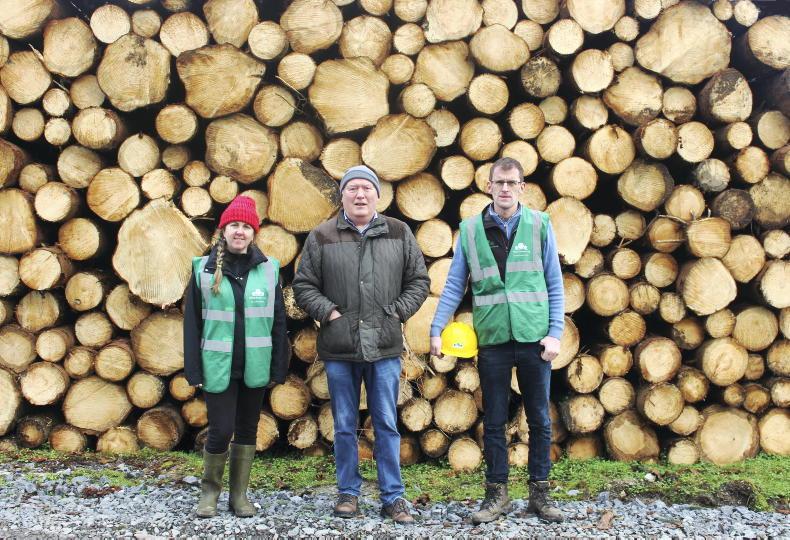


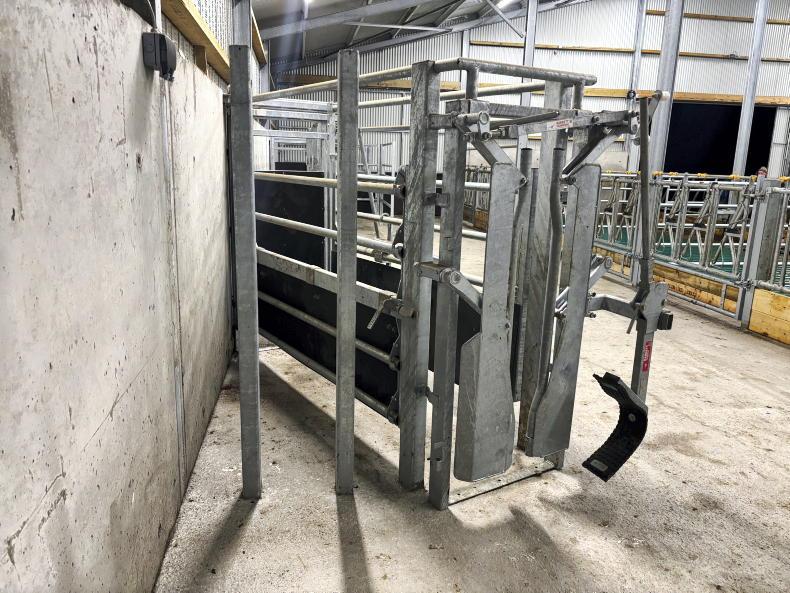
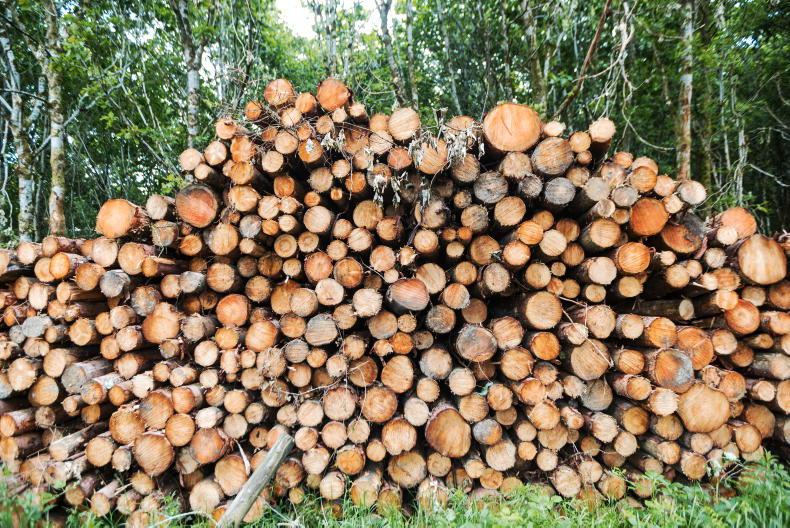
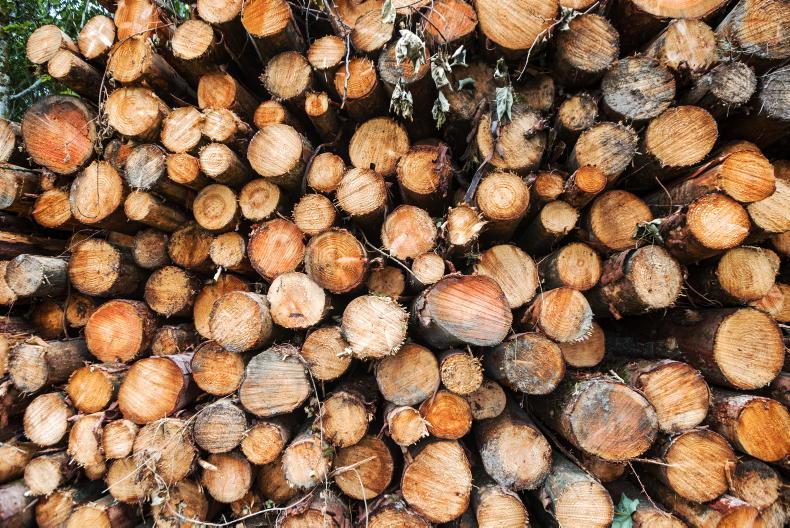
SHARING OPTIONS